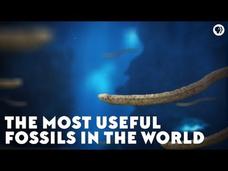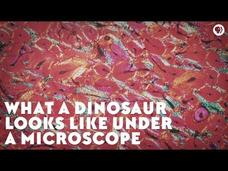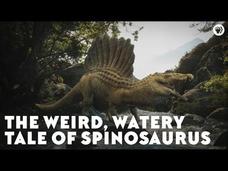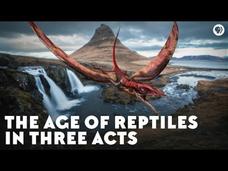TED-Ed
Why Are Fish Fish-Shaped?
Some species of fish are more closely related to humans than they are to other species of fish! How did so many species, that aren't closely related, develop the same body shape? A short video explains the evolution of fish.
TED-Ed
What Is Dust Made Of?
We find dust almost everywhere, but have you ever considered it fascinating? Dust contains a variety of materials and varies greatly based on location. After learning about dust, scholars answer multiple-choice and short-answer questions.
TED-Ed
What Causes Constipation?
Chronic constipation includes those people with fewer than five bowel movements per week. Understanding the causes of constipation helps determine appropriate treatments. Changes in diet, schedule, stress, and age alter the way our body...
TED-Ed
How to Build a Dark Matter Detector
Scientists measure dark matter based on gravity, but how do we find something that can't be detected by anything on the electromagnetic spectrum? Understanding what doesn't work leads to new tests and machines in the search for dark...
PBS
Seasonal Science: Thundersnow
Let it snow, let it snow, let it ... thundersnow? Explore the thundersnow phenomenon with a video and lesson as part of the Seasonal Science series. The video describes what causes the unique weather event, explains just how rare these...
PBS
The Other Explosion You Should Know About
Scientists replace incorrect ideas when new evidence appears, but what happens when scientists reject the new evidence? Learn the story of the Avalon explosion and the scientists who resisted the fossils proving it existed as one part of...
PBS
How the Turtle Got Its Shell
Does a shell define a turtle, or are there turtles without shells? Learn about the evolution of the unique reptile and the mystery that surrounds this identifiable feature as part of a larger series of videos. As various disciplines...
PBS
The Most Useful Fossils in the World
One of the most abundant fossils on earth confused paleontologists for more than one hundred years. Viewers learn about the mystery and discoveries related to conodonts in a video from PBS as part of its Eons series.
PBS
What a Dinosaur Looks like under a Microscope
How do scientists determine the age of a dinosaur when it died? Viewers earn how scientists make slides of dinosaur fossils and how they use these images to determine age at death. Part of a larger Eons series from PBS, these beautiful...
PBS
Inside the Dinosaur Library
Where do fossils that aren't on display in a museum go? Learn about the dinosaur collections at the Museum of the Rockies as part of the larger PBS Eons series of videos. The collections manager explains how they care for fossils and...
PBS
What Was the Ancestor of Everything?
As part of evolution species branch off of others species. But what did the original limb look like? Young scientists discover the exciting study of the last universal common ancestor as they hear from specialists in multiple scientific...
PBS
How the Squid Lost Its Shell
The ancestors of squid and octopus used shells as a form of defense. Pupils learn how cephalopods evolved without shells and the adaptations required to survive without one. Viewers learn how scientists know about these changes and the...
PBS
How the Chalicothere Split In Two
How is it that the same animal, living in the same place, at the same time, evolved into two different species? As part of a larger series, an engaging video explains the rise of the chalicothere, the split in evolution, and eventually...
PBS
The Weird, Watery Tale of Spinosaurus
While scientists have know about dinosaurs that flew in the air, lived on land, and swam in the water, a episode from the PBS Eons series reveals recent discoveries of a dinosaur that was semi-aquatic—the first known semi-aquatic...
PBS
The Age of Reptiles in Three Acts
Reptiles survived the largest extinction event on the planet and then they grew into the most dominant class of the Mesozoic Era. They quickly evolved into giants on land, sea, and air. In an episode of the PBS Eons series viewers learn...
PBS
From the Fall of Dinos to the Rise of Humans
We live in the Cenozoic Era, and most of the animals we recognize first appeared in this era. However, the animals that existed at the start of the era bear little resemblance to present day. As one part of a larger series, individuals...
PBS
That Time It Rained for Two Million Years
What would happen if all of the land on Earth received as much rainfall as the temperate rain forest? The vast desserts would be altered, the animals would adapt or die, and the types of plants available would quickly shift. This is what...
PBS
Why Triassic Animals Were Just the Weirdest
Normally when two species look similar, they are closely related. However, this doesn't seem to apply to the Triassic animals. Learn why these familiar looking animals are not actually related to today's animals. Viewers come to...
PBS
Where Did Viruses Come From?
When did things start going viral? Travel back through eons of history and learn about the origins of viruses. Part of a larger series, the lesson discusses what scientists already know and how they study viruses. The video also details...
PBS
The Facts About Dinosaurs and Feathers
Did the T. Rex have feathers? A video from the Eons series playlist explains the exciting recent findings about dinosaurs and feathers. It details the evidence, the research, and our current understanding. It also considers why dinosaurs...
Veritasium
Quantum Entanglement and Spooky Action at a Distance
Can we communicate at a speed faster than light? Part of a video series, this enthralling installment introduces the idea of Einstein's spooky action. Then, it relates and expands the concept of quantum entanglement. The results of new...
Veritasium
Should This Lake Exist?
The largest body of water in California, the Salton Sea, was created by accident. An interesting installment of a video series shares the history of the lake, which is now home to the second-most diverse group of birds in America. From...
Veritasium
Surprising Applications of the Magnus Effect
In 1852, a German physicist, Magnus, talked about an effect first described by Isaac Newton in 1672. Part of a series, an interesting video explains the Magnus effect and previous attempts to apply it to transportation. It also shows a...
PBS
Virus Wars
Unending war, battles on every front, increasing offenses and defenses as the sides adjust to each other ... these phrases describe your body fighting viruses. From a common cold to deadly Ebola, cells adjust and defend life themselves....

























